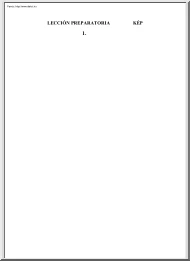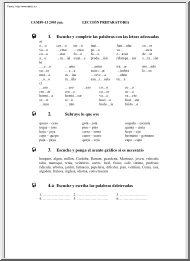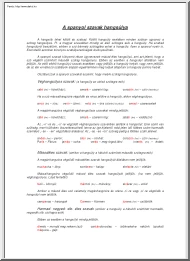Datasheet
Year, pagecount:2016, 7 page(s)
Language:English
Downloads:3
Uploaded:June 12, 2023
Size:742 KB
Institution:
-
Comments:
Attachment:-
Download in PDF:Please log in!
Comments
No comments yet. You can be the first!Most popular documents in this category
Content extract
SPANISH LANGUAGE PROFICIENCY TEST STUDY GUIDE General Test Characteristics 1. Each selected module is to be completed by all students The expectation is that students who have had one or two years of high school Spanish will answer fewer questions correctly than students who have had three or more years of high school Spanish. 2. Each module is entirely in Spanish (except for the instructions) and consists of multiplechoice questions, most with four choices each 3. The test is scored as the number of correct answers, with no penalty for guessing Each item has only one correct answer. 4. Both the Grammar & Reading Comprehension Test and the Listening Comprehension Test are designed as a test of skill, not speed. Ample time is allowed to answer questions Sixty (60) minutes are allowed to complete the Grammar and Reading Comprehension Test. Approximately thirty (30) minutes are allowed for the Listening Comprehension Test. NOTE: There is also a thirty (30) minute speaking section.
Scoring Any standard answer sheet with at least four answer options, labeled “A”, “B”, “C”, “D” may be used. Each testing institution will be provided with an Examiner’s Handbook which gives the answers so that the tests may be score locally. Test Reliability All total test reliabilities (i.e Grammar & Reading Comprehension test used in conjunction with the Listening Comprehension test) are above .90 All sub-score test reliabilities (if tests are used separately) are above .85 and most are 90 or greater For further information regarding test reliability, please see the Technical Manual (sold separately). 1 Grammar & Reading Comprehension Test The Grammar Module The grammar module of the Spanish Placement Test deals primarily with questions of syntax. Grammatical content of the texts used in the first and second year courses was analyzed noting the stage at which certain concepts were introduced and when such concepts were reviewed in the second year. Test
questions were written to measure those concepts which appeared to be important to beginning study at each course level. Great care was taken in writing questions to avoid ambiguity or arcane constructions, and problems which might require special knowledge of regional or dialectical differences. The general criterion was to write items based on constructions of acceptable grammar and high frequency of occurrence throughout the Spanishspeaking world. Two different multiple-choice formats are used. For simpler concepts, two-choice questions are used. Questions of higher complexity are written using four-choice formats In general, questions are phrased positively: e.g “which of the following choices is correct” For some types of constructions, however, the student is asked to select the work or phrase that would make the statement grammatically incorrect. To accomplish this, the committee used the following criteria: 1. No English to Spanish translation 2. No incorrect spelling or
grammatically incorrect phrases in the distractors (grammatically incorrect choices would result only from the insertion of the “wrong” answer in the sentence). 3. Limitations on lexical items to those typically found in high school texts, so that this does not become a vocabulary test. 4. Concentration on high frequency structures and on those which contrast with English 5. Exclusion of items that contain racial, cultural, or sexist bias 6. Exclusion of items that require calculation of special cultural knowledge beyond the context of the question. 7. No “trick”, contrived, or whimsical questions It is clear that there are many types of syntactic constructions which allow for a variety of acceptable alternatives or that, under certain context, could be interpreted differently. For this reason, several grammatical concepts are simply not covered in this test. 2 The following items are representative of the kind of questions students are asked to answer. Examples of Spanish
Grammar Items Part 1 Select one of the two possible choices to fill the blank space in the sentence: 1. El señor Pérez es dentist a. un b. No Change 2. es Buena para la salud a. La fruta b. fruta 3. ¡Pobre Pablo! Hoy enfermo a. está b. es 4. No cuándo vendrán a. conocemos b. sabemos 5. No veo nadie a. a b. No Change 6. La señora Díaz tiene tres hijos a. a b. No Change 3 Part 2 Select the correct choice from the four answers given: 1. ¿Preparo el almuerzo? – No, ¡no Ud! a. b. c. d. prepárelo lo prepare lo prepare los prepara 2. Pregúntele quiere a. que b. qué c. cómo d. quién 3. Los libros están en la tienda ¿ los va a buscar? a. b. c. d. que quién cuáles cuánto 4. ¿Qué blusa prefiere usted? – Prefiero a. b. c. d. el verde la verde lo verde las verdes 5. agradable de la fiesta era la comida a. b. c. d. Al El La Lo 6. No cabiá duda que ellos a. b. c. d. equivocarse se
equivocaran se habían equivocado se habrán equivocado 4 Part 3 Select the one choice which is NOT correct. Three of the choices will make the sentence grammatically correct. One will make it incorrect Select the one that makes the sentence INCORRECT. 1. los atletas a. b. c. d. Los muchachos gustan Los muchachos admiran a A los muchachos les gustan A los muchachos les encantan 2. El accidente en frente de mi casa a. b. c. d. fue estaba ocurrió tuvo lugar 5 The Reading Module An important consideration in the development of this module is comprehension of the sense of the text beyond a mere knowledge of Spanish. A large number of possible texts were considered. However, all technical, scientific, and other specialized materials, poetry and stylistically complex literature, biased or controversial readings, and texts that require wide experience in an Hispanic culture were all excluded. Passages which provided the best material for the reading test were ones
which had an internal structure independent of their original purpose. As a rule, passages filled with facts but without a clearly stated point do not meet this criterion. Variety in subject matter and content was an important objective in selection of reading passages. Where possible, the various versions of the test have included narratives, advertisements, public notices, anecdotes, jokes, character descriptions, and the like. In all cases, the original text was edited to bring it within the range of the vocabulary of the representative high school texts. Every effort was made to produce a text in which comprehension was not dependent on a key word or phrase that could not be inferred from the context. English cognates were avoided if they were uncommon in Spanish usage The authenticity of the original style was maintained wherever possible. Anglicized versions of the original Spanish were not used. Two to four questions are asked after each passage. At least one item is included
which is considered an “easy” item on a basic fact. In addition, one interpretive item is included on the sense or intent of the text as a whole. The following passage and accompanying questions are typical of the Spanish Reading Module. 6 Examples of Spanish Reading Module Para ayudar a los clients a calcular sus gastos mensuales, les ofrecemos un plan de pago en cuotas fijas a todos ellos. Este programa les permitirá distribuir a plazos iguales el costo de la electricidad durante todo el año. La cuenta mensual se basará en el promedio de consume durante un plazo de doce meses. Los primeros once meses se cobrará una cantidad fija; el ultimo mes se ajustará la cuenta de acuerdo con lo que realmente se haya consumido. 1. Bajo este plan es posible que cada mes se pague menos de lo que se debe a. Cierto b. Falso 2. La ventaja de este plan es que uno sabe cuánto tiene que pagar cada mes a. Cierto b. Falso 3. Se calcula el costo de un mes a base de lo que el cliente puede
pagar a. Cierto b. Falso 4. Según este programa, es posible que un cliente reciba dinero al fin del año a. Cierto b. Falso 7
Scoring Any standard answer sheet with at least four answer options, labeled “A”, “B”, “C”, “D” may be used. Each testing institution will be provided with an Examiner’s Handbook which gives the answers so that the tests may be score locally. Test Reliability All total test reliabilities (i.e Grammar & Reading Comprehension test used in conjunction with the Listening Comprehension test) are above .90 All sub-score test reliabilities (if tests are used separately) are above .85 and most are 90 or greater For further information regarding test reliability, please see the Technical Manual (sold separately). 1 Grammar & Reading Comprehension Test The Grammar Module The grammar module of the Spanish Placement Test deals primarily with questions of syntax. Grammatical content of the texts used in the first and second year courses was analyzed noting the stage at which certain concepts were introduced and when such concepts were reviewed in the second year. Test
questions were written to measure those concepts which appeared to be important to beginning study at each course level. Great care was taken in writing questions to avoid ambiguity or arcane constructions, and problems which might require special knowledge of regional or dialectical differences. The general criterion was to write items based on constructions of acceptable grammar and high frequency of occurrence throughout the Spanishspeaking world. Two different multiple-choice formats are used. For simpler concepts, two-choice questions are used. Questions of higher complexity are written using four-choice formats In general, questions are phrased positively: e.g “which of the following choices is correct” For some types of constructions, however, the student is asked to select the work or phrase that would make the statement grammatically incorrect. To accomplish this, the committee used the following criteria: 1. No English to Spanish translation 2. No incorrect spelling or
grammatically incorrect phrases in the distractors (grammatically incorrect choices would result only from the insertion of the “wrong” answer in the sentence). 3. Limitations on lexical items to those typically found in high school texts, so that this does not become a vocabulary test. 4. Concentration on high frequency structures and on those which contrast with English 5. Exclusion of items that contain racial, cultural, or sexist bias 6. Exclusion of items that require calculation of special cultural knowledge beyond the context of the question. 7. No “trick”, contrived, or whimsical questions It is clear that there are many types of syntactic constructions which allow for a variety of acceptable alternatives or that, under certain context, could be interpreted differently. For this reason, several grammatical concepts are simply not covered in this test. 2 The following items are representative of the kind of questions students are asked to answer. Examples of Spanish
Grammar Items Part 1 Select one of the two possible choices to fill the blank space in the sentence: 1. El señor Pérez es dentist a. un b. No Change 2. es Buena para la salud a. La fruta b. fruta 3. ¡Pobre Pablo! Hoy enfermo a. está b. es 4. No cuándo vendrán a. conocemos b. sabemos 5. No veo nadie a. a b. No Change 6. La señora Díaz tiene tres hijos a. a b. No Change 3 Part 2 Select the correct choice from the four answers given: 1. ¿Preparo el almuerzo? – No, ¡no Ud! a. b. c. d. prepárelo lo prepare lo prepare los prepara 2. Pregúntele quiere a. que b. qué c. cómo d. quién 3. Los libros están en la tienda ¿ los va a buscar? a. b. c. d. que quién cuáles cuánto 4. ¿Qué blusa prefiere usted? – Prefiero a. b. c. d. el verde la verde lo verde las verdes 5. agradable de la fiesta era la comida a. b. c. d. Al El La Lo 6. No cabiá duda que ellos a. b. c. d. equivocarse se
equivocaran se habían equivocado se habrán equivocado 4 Part 3 Select the one choice which is NOT correct. Three of the choices will make the sentence grammatically correct. One will make it incorrect Select the one that makes the sentence INCORRECT. 1. los atletas a. b. c. d. Los muchachos gustan Los muchachos admiran a A los muchachos les gustan A los muchachos les encantan 2. El accidente en frente de mi casa a. b. c. d. fue estaba ocurrió tuvo lugar 5 The Reading Module An important consideration in the development of this module is comprehension of the sense of the text beyond a mere knowledge of Spanish. A large number of possible texts were considered. However, all technical, scientific, and other specialized materials, poetry and stylistically complex literature, biased or controversial readings, and texts that require wide experience in an Hispanic culture were all excluded. Passages which provided the best material for the reading test were ones
which had an internal structure independent of their original purpose. As a rule, passages filled with facts but without a clearly stated point do not meet this criterion. Variety in subject matter and content was an important objective in selection of reading passages. Where possible, the various versions of the test have included narratives, advertisements, public notices, anecdotes, jokes, character descriptions, and the like. In all cases, the original text was edited to bring it within the range of the vocabulary of the representative high school texts. Every effort was made to produce a text in which comprehension was not dependent on a key word or phrase that could not be inferred from the context. English cognates were avoided if they were uncommon in Spanish usage The authenticity of the original style was maintained wherever possible. Anglicized versions of the original Spanish were not used. Two to four questions are asked after each passage. At least one item is included
which is considered an “easy” item on a basic fact. In addition, one interpretive item is included on the sense or intent of the text as a whole. The following passage and accompanying questions are typical of the Spanish Reading Module. 6 Examples of Spanish Reading Module Para ayudar a los clients a calcular sus gastos mensuales, les ofrecemos un plan de pago en cuotas fijas a todos ellos. Este programa les permitirá distribuir a plazos iguales el costo de la electricidad durante todo el año. La cuenta mensual se basará en el promedio de consume durante un plazo de doce meses. Los primeros once meses se cobrará una cantidad fija; el ultimo mes se ajustará la cuenta de acuerdo con lo que realmente se haya consumido. 1. Bajo este plan es posible que cada mes se pague menos de lo que se debe a. Cierto b. Falso 2. La ventaja de este plan es que uno sabe cuánto tiene que pagar cada mes a. Cierto b. Falso 3. Se calcula el costo de un mes a base de lo que el cliente puede
pagar a. Cierto b. Falso 4. Según este programa, es posible que un cliente reciba dinero al fin del año a. Cierto b. Falso 7





 When reading, most of us just let a story wash over us, getting lost in the world of the book rather than paying attention to the individual elements of the plot or writing. However, in English class, our teachers ask us to look at the mechanics of the writing.
When reading, most of us just let a story wash over us, getting lost in the world of the book rather than paying attention to the individual elements of the plot or writing. However, in English class, our teachers ask us to look at the mechanics of the writing.